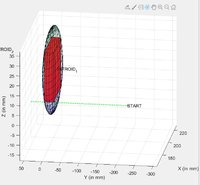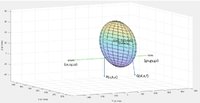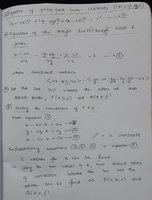Let's look at the point first.
Suppose START is at P(x,y,z), and the center of the sphere is at C(a,b,c), with radius r.
Find the distance between C and P, and call that d. Form the vector
v = CP, whose length is d; you want the vector
u in the same direction with length r, which will be (r/d)
v. Add that to the position vector for C, and you've found the point you want.
For the arc (an arc of a circle on the surface of the sphere), we need to know what you need to specify it. That depends on how you are planning to implement this. If you're going to draw it using some graphics package, for example, we need to know what input it will need. You said:
My objective is to find the equations of the major and minor an arcs at the periphery of the sphere, passing through the intersection of the line (represented by the green dots) and the sphere.
And I want to find the coordinates of all the points in those arcs.
It is a sphere, not an ellipsoid (it appears distorted due to the lack of aspect ratio)
We can't give you a list of all the points; we could give you an equation of a circle in various forms, together with an inequality to restrict that to one arc of the circle. Probably a parametric form would be most suitable. On the other hand, depending on your project, it is probably better to do what this site is meant to do, and help you learn enough to work out those details yourself, and understand what you are doing.






